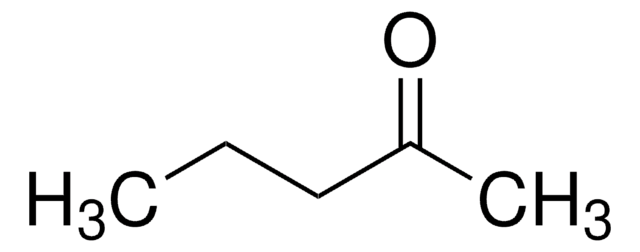360473
2-Butanone
ACS reagent, ≥99.0%
Synonym(s):
Ethyl methyl ketone, MEK, Methyl ethyl ketone
About This Item
Recommended Products
grade
ACS reagent
Quality Level
vapor density
2.49 (vs air)
vapor pressure
71 mmHg ( 20 °C)
Assay
≥99.0%
form
liquid
autoignition temp.
960 °F
expl. lim.
10.1 %
impurities
≤0.0005 meq/g Titr. acid
≤0.20% water
evapn. residue
≤0.0025%
color
APHA: ≤15
refractive index
n20/D 1.379 (lit.)
bp
80 °C (lit.)
mp
−87 °C (lit.)
density
0.805 g/mL at 25 °C (lit.)
SMILES string
CC(CC)=O
InChI
1S/C4H8O/c1-3-4(2)5/h3H2,1-2H3
InChI key
ZWEHNKRNPOVVGH-UHFFFAOYSA-N
Looking for similar products? Visit Product Comparison Guide
General description
Application
- To synthesize waterborne polyurethanes by reacting polyols and diisocyanates via polymerization reaction.
- In the Al-catalyzed chemoselective coupling of oxetanes and carbon dioxide to synthesize six-membered cyclic carbonates.
Features and Benefits
- Low-boiling solvent
- High power of dissolution
- High ratio of dissolved matter to viscosity
- Miscible with a wide range of hydrocarbonswithout affecting the solid′s content or viscosity
- Favorable volume/mass ratio due to its low density
- Fast evaporation rate
Signal Word
Danger
Hazard Statements
Precautionary Statements
Hazard Classifications
Eye Irrit. 2 - Flam. Liq. 2 - STOT SE 3
Target Organs
Central nervous system
Supplementary Hazards
Storage Class Code
3 - Flammable liquids
WGK
WGK 1
Flash Point(F)
30.2 °F - closed cup
Flash Point(C)
-1 °C - closed cup
Certificates of Analysis (COA)
Search for Certificates of Analysis (COA) by entering the products Lot/Batch Number. Lot and Batch Numbers can be found on a product’s label following the words ‘Lot’ or ‘Batch’.
Already Own This Product?
Find documentation for the products that you have recently purchased in the Document Library.
Customers Also Viewed
Our team of scientists has experience in all areas of research including Life Science, Material Science, Chemical Synthesis, Chromatography, Analytical and many others.
Contact Technical Service





